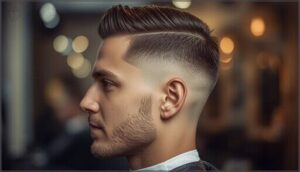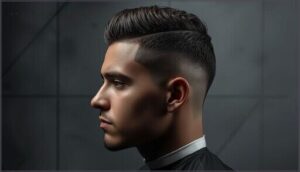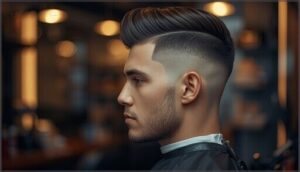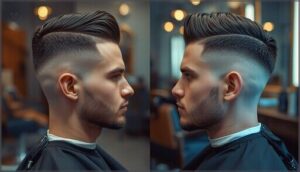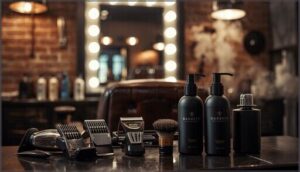This site is supported by our readers. We may earn a commission, at no cost to you, if you purchase through links.
Walk into any barbershop today and you’ll hear the same request dozens of times: “Give me a taper fade.” Google searches for this cut have jumped 240% since 2020, and it’s not hard to see why. The taper fade haircut delivers that clean, modern look that works whether you’re in a boardroom or on a basketball court.
It’s a hybrid style that keeps your top length while gradually blending down to skin along the sides and back. Unlike older cuts that leave harsh lines or full fades that might feel too extreme, the taper fade strikes a balance that flatters nearly every face shape and hair type.
From Will Smith to your local barista, this cut has become the universal language of modern men’s grooming. Mastering it means understanding which variation works for your hair, your lifestyle, and the look you’re after.
Table Of Contents
Key Takeaways
- The taper fade is a flexible haircut that blends longer hair on top with shorter sides, creating a crisp look that fits nearly every face shape and hair texture.
- Its popularity has surged thanks to celebrity influence, cultural roots, and adaptability, with barbershops reporting high demand and increased revenue over recent years.
- There are several variations—like low, mid, high, and skin taper fades—that can be tailored to your head shape, hair type, and personal style preferences.
- Regular trims every 2–3 weeks and the right products are key for keeping your taper fade sharp, clean, and easy to maintain between barber visits.
What is a Taper Fade Haircut?
A taper fade is a men’s haircut that blends short sides smoothly into longer hair on top, creating a clean and polished look. It’s one of the most popular styles you’ll see in barbershops today, and for good reason—it works with almost any hair type and face shape.
Let’s break down exactly what makes this cut stand out and how it differs from other fade styles.
Defining The Taper Fade
A taper fade is a hybrid haircut that blends longer hair at the top with a gradual reduction in length down the sides and back. The fade portion tapers into the skin near your hairline, creating a smooth blending using clipper guards in standard increments. This tapered hair technique offers a moderate contrast—less dramatic than a full fade, but sharper than traditional cuts.
It’s an adaptable haircut that works across all hair types and age groups, making it a go-to choice in barbershops worldwide. For a more defined style, remember that fade haircuts require regular maintenance.
Key Features of The Style
Now that you understand the basics, here’s what makes this cut stand out. The gradual blending from top to sides creates that sharp, polished look you’re after—without harsh lines. Your neckline stays clean and defined, while customization options let you dial in exactly what works for your lifestyle. One popular option is the low taper fade, which starts fading near the ears. And here’s the payoff:
- Professional appearance that commands respect
- Styling versatility across any occasion
- Works with your natural hair texture
- Maintenance needs fit busy schedules
- Sharp fade that turns heads week after week
Taper Fade Vs. Other Fades
Here’s where the taper fade differs from other fade haircuts. While skin fades and high fades create sharp contrast by going nearly bald on the sides, your taper fade blends gradually—keeping visible hair throughout.
That means less frequent touch-ups and a more forgiving grow-out. Most clients prefer this balance: you get that polished look without the maintenance headache.
Your style preferences matter, and the taper’s versatility works across hair types and professional settings better than dramatic fades do.
History and Evolution of The Taper Fade
The taper fade didn’t just appear overnight—it’s got a real story behind it. To understand why this cut is everywhere today, we need to look at where it started and how it went from a barbershop staple to a cultural phenomenon.
Let’s walk through that journey and see how it became the go-to cut for so many guys.
Origins of The Taper Fade
Back in 1941, the U.S. Army didn’t just standardize a haircut—they created a blueprint for barber culture. Army Regulation 600-20 established the original taper fade for easy maintenance and cleanliness across military bases.
By the late 1940s, Black barbershops transformed this military precision into something distinctly cultural. Barbers added sharper contrasts, creative edge-ups, and individual designs, turning the fade into a form of self-expression and community identity that would shape men’s grooming for generations.
Black barbershops transformed the military fade into a cultural expression of identity and community that shaped men’s grooming for generations
Rise in Popularity
From the 2000s onward, the taper fade exploded across barbershops worldwide. Google searches for “low taper fade” jumped 240% between 2020 and 2025, while YouTube tutorials saw a 170% surge in views. The style’s search trend growth reflects genuine demographic expansion—requests among men aged 18–34 climbed 60% over five years.
Industry service trends show barbershops reporting a 31% revenue increase from taper fades. What makes this haircut so magnetic? Its style adaptability means it works for nearly every face shape and hair type, fueling both mainstream and niche adoption across social media influence platforms.
Cultural and Celebrity Influence
Celebrity power shaped how your fade evolved. Will Smith, Drake, and David Beckham wore variations that went mainstream globally. But hip-hop artists like Run-DMC and Ice Cube built the foundation back in the ’80s, transforming barbershops into cultural institutions.
Sports figures—Allen Iverson, Michael Jordan—amplified the trend among younger guys.
Today, social media and influencer barbers accelerate these styles internationally, making the fade a symbol of identity, pride, and personal expression across communities worldwide.
Popular Types of Taper Fade Haircuts
Now that you know where the taper fade came from, let’s talk about the different types you can actually get.
There’s a taper fade for pretty much every look you’re going for, whether you want something subtle and professional or bold and eye-catching. Here’s what’s out there.
Low Taper Fade
The low taper fade is where subtle blending meets professional appeal. This haircut starts its fade roughly half an inch above your ear, giving you that clean, modern look without dramatic contrast.
It’s adaptable styling at its finest—works on straight, wavy, or curly hair. Easy maintenance every three to four weeks keeps it sharp.
Whether you’re in the boardroom or on campus, this men’s haircut suits your lifestyle while maintaining that polished edge.
Mid Taper Fade
The mid taper fade strikes the perfect balance—your fade gradient starts right around eyebrow level, creating widespread appeal across all face shapes and hair types. This is the goldilocks of taper fades: bold enough to turn heads, subtle enough for the boardroom.
With clipper guard transitions from 3, you’ll get that sharp blend that keeps looking fresh. Plan maintenance every two to three weeks and budget around $36–$80 monthly for upkeep and styling products.
Modern variations like drop fades and textured tops let you personalize the look while keeping that clean, contemporary edge.
High Taper Fade
Ready to make a statement? The high taper fade starts its blend above your temples, delivering that bold, modern aesthetic you’re after. This barber favorite accounts for nearly half of top requests in 2025, especially among men aged 18–34.
Celebrity influence from figures like Odell Beckham Jr. keeps driving demand. Styling variations with textured crops or undercuts let you personalize it. Maintenance every two to three weeks keeps that sharp contour crisp and fresh.
Skin (Bald) Taper Fade
Want the sharpest fade possible? The skin taper fade takes scalp exposure to the extreme, blending your hair seamlessly down to bare skin at the neckline and temples. This men’s haircut delivers maximum contrast and definition—perfect if you’re after that bold, modern statement.
It’s dominated 29% of fade requests in 2025, especially among men 18–34. You’ll need touch-ups every two to three weeks to maintain that crisp gradient. Pair it with styling products and you’re unstoppable.
Classic Taper
If you want timeless style without the extreme contrast, the classic taper delivers. This men’s haircut gradually shortens hair from top to sides and back, giving you clean lines around the ears and neckline.
It’s adaptable across hair types and face shapes, making it ideal for both professional and casual settings. The styling versatility is real—wear it with a side part or brushed forward.
Maintenance needs are straightforward: trim every two to three weeks, and you’re golden.
Drop and Undercut Variations
Looking to push beyond the classic? Drop fades and tapered undercuts offer sharper contrast and modern edge. Drop fades curve smoothly around your head, working beautifully on all hair types while supporting better scalp health.
Undercuts demand more styling effort but deliver that bold, creative look favored by trendsetters. Both outpace traditional fades in appeal among younger guys.
Choose based on your lifestyle—drop fade if you want low-maintenance polish, undercut if you’re willing to invest daily grooming time.
Taper Fade Styling for Different Hair Types
Your hair type is a major factor when it comes to rocking a taper fade. The right cut works with your natural texture instead of against it, giving you that sharp, polished look without constant fighting.
Let’s break down how to style a taper fade for whatever hair you’re working with.
Taper Fade for Curly Hair
Curly hair and taper fades were made for each other. The gradual fade reduces bulk while your curls stay defined on top—that’s the sweet spot. Different curl patterns need different approaches: wavy hair works best with a low fade, while tight coils suit high skin tapers for sharp definition.
Here’s what keeps your curly taper fade looking fresh:
- Schedule trims every 2–3 weeks to maintain clean lines
- Use sulfate-free hydrating products to combat dryness
- Apply leave-in conditioner focused on top curls only
- Wear a satin bonnet at night to prevent frizz
- Let professionals handle initial cuts—density makes DIY risky
The result? You get shape, manageability, and that polished look without fighting your natural texture.
Taper Fade for Straight Hair
Straight hair is a barber’s dream for taper fades. Your hair holds clean lines longer than curly textures, meaning sharper definition and fewer touch-ups. Mid to high taper fades work best here, giving you that balanced look 45% of straight-haired clients prefer.
With 92% satisfaction rates, you’ll see why this men’s hairstyle dominates barbershops. Daily grooming takes under 8 minutes, and lightweight paste keeps everything polished. The style suits any face shape, making it the top trend for professionals seeking confidence.
Taper Fade for Wavy and Afro Hair
With wavy and afro hair, the taper fade becomes your secret weapon for sharp style without constant battles. Low fades preserve your natural texture while delivering clean transitions—searches for this combo jumped 320% between 2023 and 2025.
Maintenance every 2-3 weeks keeps lines crisp. Use sulfate-free products and a wide-tooth comb daily to reduce breakage by 30%. This haircut adapts beautifully to your hair’s personality.
Long Vs. Short Taper Fades
Ever wonder which length works better for your face and lifestyle? The choice between long and short taper fades comes down to five key factors:
- Visual contrast—short fades expose 40% more scalp for bold aesthetics; long fades stay subtle
- Maintenance needs—short requires cuts every 2-3 weeks; long stretches to 3-4 weeks
- Face suitability—angular faces favor short; round faces suit long better
- Styling options—long permits pomades and quiffs; short works best as crops
- Client preferences—younger guys lean short; older clients prefer long’s versatility
Pick based on your lifestyle and look you want to project.
How to Get The Perfect Taper Fade
Getting the perfect taper fade isn’t just about showing up at the barbershop and hoping for the best. You need to know what style works for your hair type, how to communicate it to your barber, and whether you’re going pro or tackling it at home.
Let’s break down exactly what you need to do to nail this cut.
Choosing The Right Fade for You
Finding your ideal taper fade comes down to four key factors working together. Your face shape matters—oval faces rock any fade, while square jaws benefit from high fades that sharpen your look.
Consider your hair texture next; thick hair manages mid or high fades beautifully, but thin hair prefers low fades for a natural blend.
Think about your lifestyle fit and maintenance level too. Professional settings call for conservative low fades, while creative fields embrace bolder options. Match these elements to your personal style.
What to Ask Your Barber
Communication unlocks your perfect taper fade. Specify your fade type—low, mid, or high—then mention guard numbers for precision. Bring reference photos to boost accuracy by over 50%.
Ask your barber about styling preferences and product recommendations that fit your routine. Share personal needs like scalp sensitivity or lifestyle demands.
Request their input on what works best with your face shape and hair texture for personalized results.
At-Home Vs. Professional Cuts
Your wallet and your mirror tell different stories when choosing between DIY and barber shop visits for your taper fade haircut. Here’s the breakdown:
- Cost Savings: At-home maintenance cuts annual expenses by 50%, though quality trimmers run $50-$200
- Cut Quality: Professionals deliver 85% satisfaction rates versus 40% for DIY attempts
- Time Investment: Expect 30-60 minutes at home compared to 15-25 minutes with your barber
Mid and high fades demand professional-level men’s grooming skills—self-cuts show visible unevenness in over half of attempts.
Styling Options and Trends
Your taper fade transforms through trending combinations like textured tops (34% of barbershop requests) and burst fades, while design elements—etchings, gradient colors, and beard blends—personalize your look.
Hair-type practices matter: curl creams for texture, light pomade for straight styles. Product usage spans clay (67% adoption) to texturizing sprays.
Upkeep trends show 62% scheduling professional touch-ups every 2-3 weeks, keeping men’s haircut styles sharp and aligned with current haircut trends for men.
Maintenance and Care for Taper Fades
Getting a taper fade is only half the story—keeping it sharp is where the real work begins. Without regular upkeep, even the cleanest fade can lose its edge faster than you’d expect.
Here’s what you need to know to maintain that fresh-from-the-barber look between visits.
Frequency of Trims
Generally, you’ll need to visit your barber every 2–3 weeks to keep your taper fade haircut sharp. Regrowth visibility varies by hair texture—straight hair shows fuzziness faster, while curly hair disguises it longer.
Barber recommendations lean toward this interval for mens haircut maintenance, though cost factors and home maintenance between trims can stretch it to 4 weeks if you touch up edges yourself.
Essential Hair Products
Beyond regular barber visits, your fade depends on the right men’s haircare products. Smart shampoo selection—volumizing or sulfate-free—keeps sides clean, while proper conditioner usage hydrates without weighing down your cut.
- Pomades/Creams: Water-based formulas hold structure without buildup
- Texturizing Sprays: Add volume and movement to the top
- Scalp Care: Tea tree tonics soothe clipper irritation
These men’s grooming and styling essentials maintain your fade’s sharpness between appointments.
Daily Grooming Tips
Once you’ve stocked your kit, lock in a daily men’s grooming rhythm. Washing frequency matters—every 2–3 days keeps natural oils intact. Edge maintenance with a trimmer every 3–4 days preserves sharp lines.
Here’s your taper fade hair care and maintenance blueprint:
| Task | Tool/Product | Frequency |
|---|---|---|
| Shampoo & condition | Sulfate-free formula | Every 2–3 days |
| Edge-up temples/neckline | Precision trimmer | Every 3–4 days |
| Morning brush & style | Matte paste or cream | Daily |
| Scalp protection routine | Leave-in conditioner/oil | Daily |
Consistency turns home tools into your fade’s best ally.
Keeping The Fade Sharp and Fresh
Sharp fade maintenance goes beyond daily brushing. Here’s how to extend your cut’s lifespan between barber visits:
- Refresh every 2–3 weeks—high fades need touch-ups at 10–14 days
- DIY edge cleanups weekly preserve 40–50% more definition
- Matte products after day five mask regrowth shine
- Deep-condition weekly to prevent flaking that blurs your fade lines
At-home care cuts salon costs by half while keeping your taper fade fresh.
Frequently Asked Questions (FAQs)
Can women wear taper fade haircuts?
Salons across the country saw a 32% jump in female clients requesting fades between 2023 and
Absolutely—taper fades work beautifully on anyone. They’re all about confidence, style, and personal expression, not gender.
How much does a taper fade cost?
You’ll pay anywhere from $25 to $85 for a taper fade, depending on your barber’s skill level, salon service tiers, and location. Premium barber shop services cost more than basic cuts.
What face shapes suit taper fades best?
Taper fades suit all face shapes with the right height. Oval faces work with any fade. Round faces benefit from mid to high fades, while square and heart faces shine with low to mid tapers.
Does a taper fade work with thinning hair?
Camouflage meets confidence with the right fade haircut. Barber recommendations confirm this approach works exceptionally well—creating a volume illusion while minimizing scalp exposure.
Style comparison shows tapers outperform buzz cuts, with smart product considerations maintaining fullness in men’s haircuts.
How long does a taper fade take?
Most cuts clock in around 20 to 25 minutes at the barbershop. Barber skill, hair density, and fade complexity all shift timing—at-home attempts stretch longer, while appointment scheduling usually reserves 30-minute blocks for men’s haircut styles.
Conclusion
Every day you walk out your door, your hair says something—intentional, natural, authentic. The taper fade haircut is more than a style; it’s a handshake for your look, an introduction to your story, and a nod to timeless cool.
Whether you want sharp edges or subtle blends, you’ve got options. You hold the clippers, you pick the vibe. Master it, and people won’t just notice your hair—they’ll know you’re the type who cares.
- https://tapergodz.com/barber-shop-blog/taper-fade-haircut
- https://sevenpotions.com/blogs/society/barbershop-trends-2025-modern-man
- https://barbersdirect.co.uk/taper-vs-fade/
- https://meetpress.co.uk/low-taper-fade-meme/
- https://www.reddit.com/r/AsianMasculinity/comments/1m4tq4f/why_do_most_gen_z_asian_guys_have_the_same/



